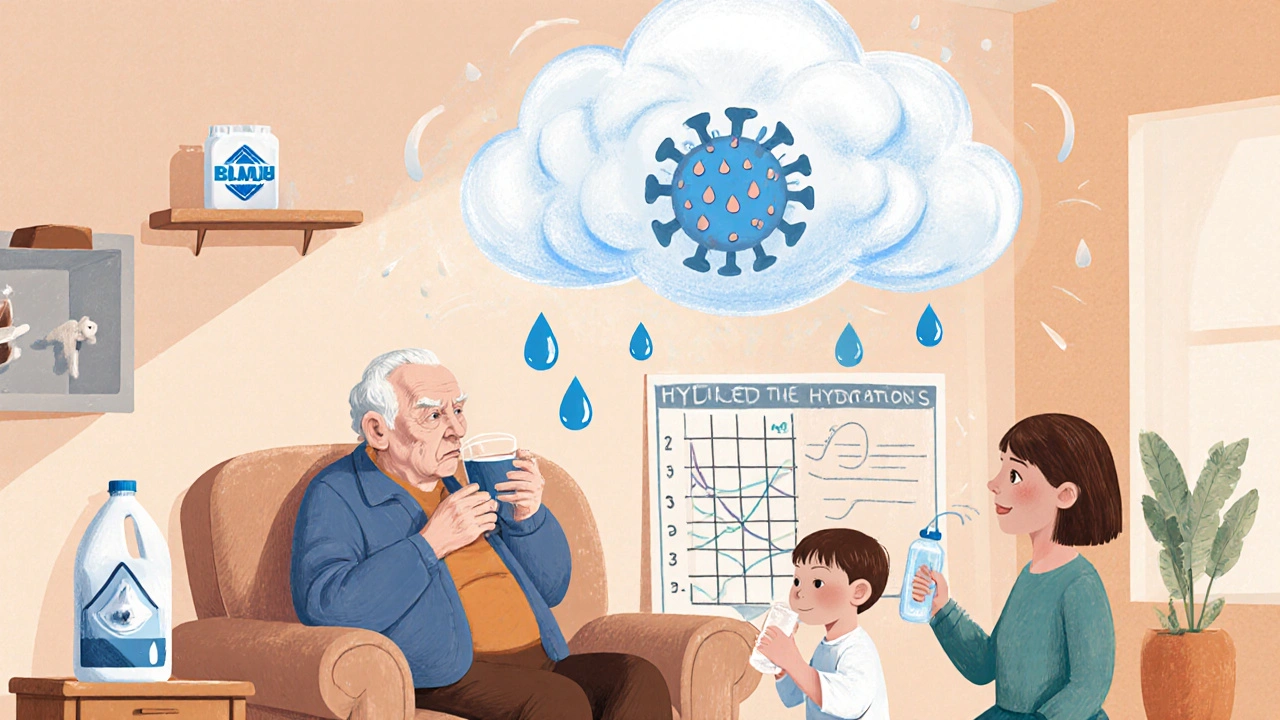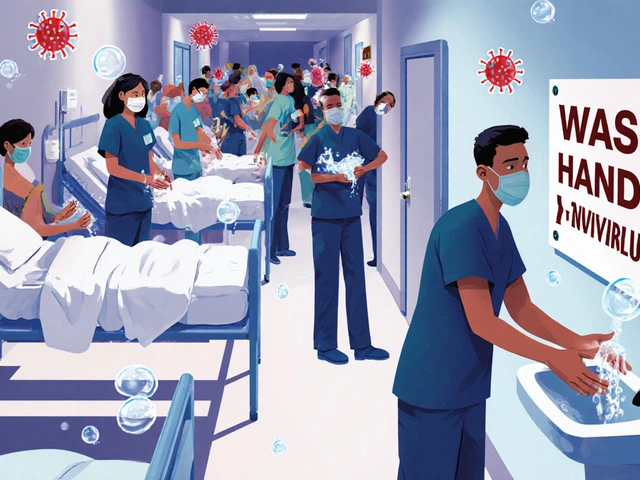What Is Norovirus and Why Does It Spread So Fast?
Norovirus is the most common cause of stomach flu in the U.S., hitting 19 to 21 million people every year. It doesn’t care if you’re young or old, healthy or sick - it just wants to spread. One tiny piece of the virus - as few as 18 particles - is enough to make you sick. That’s why outbreaks happen so quickly in places like hospitals, nursing homes, schools, and even cruise ships.
You catch it by touching something contaminated - a doorknob, a countertop, a spoon - and then touching your mouth. Or by eating food handled by someone who’s infected. Even if someone doesn’t feel sick yet, they can still spread the virus. And here’s the kicker: people keep shedding the virus for days after they feel better. Some, especially those with weak immune systems, can spread it for weeks.
How Norovirus Moves: The Real Transmission Routes
Most outbreaks aren’t caused by bad food alone. In fact, only about 23% of cases come from contaminated food. The biggest culprit? Person-to-person contact. Around 62% of outbreaks happen because someone who’s sick didn’t wash their hands properly after using the bathroom - and then touched something someone else touched.
Surfaces stay dangerous for up to 12 days. A doorknob, a bed rail, a toilet flush handle - if an infected person touches it, the virus sticks around. Waterborne outbreaks are rare but still happen, especially in places with poor sanitation. And yes, vomiting aerosolizes the virus. When someone throws up, tiny droplets go into the air and land on surfaces, clothes, even food.
Food handlers are a major risk. If someone works in a kitchen while sick, they can contaminate ready-to-eat foods like salads, sandwiches, or cooked meats. That’s why health departments require food workers to stay home for at least 48 to 72 hours after symptoms stop - longer in healthcare settings.
Stopping the Spread: What Actually Works
There’s no magic bullet. You need a full team effort. The CDC says the most important things are handwashing, cleaning, and isolation - not hand sanitizer.
Handwashing with soap and water is non-negotiable. Alcohol-based sanitizers don’t kill norovirus. You need to scrub for at least 20 seconds - the time it takes to sing "Happy Birthday" twice. Do it after using the bathroom, before eating, and after cleaning up vomit or diarrhea. In hospitals and nursing homes, handwashing stations should be placed right outside outbreak areas to make it easier for staff to comply.
Environmental cleaning needs bleach. Regular disinfectants won’t cut it. Use a bleach solution: 5 to 25 tablespoons of household bleach per gallon of water. That’s 1,000 to 5,000 ppm. Clean high-touch surfaces every few hours - door handles, light switches, call buttons, railings, and bathroom fixtures. For terminal cleaning after an outbreak, some hospitals now use hydrogen peroxide vapor systems, which kill 99.9% of the virus.
Isolate sick people. Put them in single rooms if possible. If not, group them together away from others. Keep them isolated for at least 48 hours after symptoms stop. Don’t move people around - even if they don’t feel sick yet. Research shows about 30% of infected people don’t have symptoms but still shed the virus.

Hydration: The Most Important Treatment
Norovirus doesn’t kill you directly. It kills you by dehydrating you. Vomiting and diarrhea can drain fluids faster than you can replace them - especially in kids, the elderly, and people with chronic illnesses.
For mild to moderate dehydration, oral rehydration therapy (ORT) is the gold standard. It’s not just water. It’s a balanced mix of salt, sugar, and potassium. WHO-recommended solutions have 50-90 mmol/L sodium, 75-100 mmol/L glucose, and 20-25 mmol/L potassium. You can buy pre-made packets at pharmacies, or make your own: 1 liter of clean water, 6 teaspoons of sugar, and half a teaspoon of salt.
Give small sips often - a tablespoon every 5 to 10 minutes. Don’t wait until someone is thirsty. Elderly people often don’t feel thirsty even when they’re dehydrated. Check for dry mouth, sunken eyes, less urine, dizziness, or confusion. In nursing homes, check residents every 4 to 6 hours during an outbreak.
If someone can’t keep fluids down, or shows signs of severe dehydration (rapid heartbeat, low blood pressure, no urine for 12 hours), they need IV fluids. Hospitals use 0.9% saline or lactated Ringer’s. A typical first dose is 20 mL per kilogram of body weight - that’s about 1.5 liters for a 70 kg adult - given over 15 to 30 minutes.
Special Cases: Who’s at Highest Risk?
Infants and toddlers lose fluids fast. Give them 50-100 mL of ORT after each episode of vomiting or diarrhea. Don’t force food. Let them sip slowly. Avoid sugary drinks like juice or soda - they make diarrhea worse.
Elderly patients are especially vulnerable. Their bodies don’t hold water well. They may not feel thirsty. They might have heart or kidney problems that make fluid balance tricky. Monitor their urine output. A drop in urine means they’re dehydrating. Watch for confusion - that’s often the first sign of trouble in older adults.
People with weak immune systems - from chemotherapy, transplants, or chronic illness - can shed the virus for weeks. They need longer isolation. Their hydration needs are higher and last longer. Don’t assume they’re fine just because they look better.
Visitor Rules and Staff Training
Visitors can be silent spreaders. During an outbreak, limit visitors to essential ones only. Anyone who comes in must wash their hands before entering and leaving the unit. They should be told to stay home if they’ve had stomach issues in the last 48 hours.
Staff training is critical. In California, facilities must train all staff within 24 hours of an outbreak. That includes nurses, aides, cleaners, and even kitchen staff. Cover: how to wash hands correctly, how to use PPE, how to clean properly, and how to recognize early signs of dehydration. When staff are rushed, hand hygiene drops by 25-30%. That’s why reminders, signs, and easy access to soap and water matter.

What Doesn’t Work - And Why
Alcohol-based hand sanitizers? Useless against norovirus. They kill other germs, but not this one. Don’t rely on them.
Antibiotics? They don’t work on viruses. Giving them just adds risk of side effects and antibiotic resistance.
Staying home for 24 hours after symptoms stop? Not enough. You need 48 hours. Some people still shed virus at day 3.
Ignoring asymptomatic carriers? Big mistake. You can’t see the virus, but it’s still there. Treat everyone in an outbreak zone as potentially contagious.
What’s Coming Next?
There’s hope on the horizon. Takeda’s norovirus vaccine showed 46.7% effectiveness in early trials. If approved in 2025 as expected, it could be a game-changer - especially for nursing homes and hospitals. But until then, the tools we have are simple, cheap, and effective: wash hands, clean with bleach, hydrate early, and isolate fast.
Outbreaks are predictable. They spike between November and March. They happen when staffing is low. They spread when protocols are rushed. The fix isn’t fancy. It’s consistent. It’s discipline. It’s doing the basics - over and over - even when you’re tired.
Can you get norovirus more than once?
Yes. There are many strains of norovirus, and immunity after an infection is short-lived - usually just a few months. You can catch a different strain even if you just had one. That’s why outbreaks keep happening, even in people who’ve been sick before.
Is norovirus dangerous for healthy adults?
For most healthy adults, it’s unpleasant but not life-threatening. Symptoms usually last 1 to 3 days. The main risk is dehydration. If you can keep fluids down and rest, you’ll recover on your own. But if you’re vomiting constantly or can’t keep anything down for more than a day, seek medical help.
Should I use bleach to clean my kitchen after someone gets sick?
Yes, but be careful. Mix 1 cup of household bleach (5.25% concentration) with 1 gallon of water. Apply it to surfaces like countertops, sinks, and fridge handles. Let it sit for 10 minutes, then rinse with clean water. Wear gloves and open windows. Don’t mix bleach with ammonia or vinegar - it creates toxic fumes.
How long should a food worker stay home after vomiting?
At least 48 hours after symptoms stop. In healthcare settings, restaurants, or nursing homes, wait 72 hours. Even if you feel fine, you can still spread the virus. It’s not just about feeling better - it’s about stopping transmission.
Can pets get norovirus and spread it to people?
No. Norovirus is specific to humans. Pets can get their own types of gastroenteritis, but they don’t carry or spread human norovirus. Don’t worry about your dog or cat being a source of infection.
What to Do Next - Simple Steps to Protect Yourself
- If someone in your home is sick: wash hands with soap and water after every bathroom visit, before eating, and before touching anything they’ve touched.
- Disinfect bathrooms and kitchens daily with bleach solution - especially toilets, sinks, and doorknobs.
- Keep sick people isolated. Don’t share towels, utensils, or bedding.
- Give small sips of oral rehydration solution often - don’t wait for thirst.
- Stay home if you’re sick. Don’t go to work, school, or public places for at least 48 hours after symptoms stop.
There’s no cure for norovirus. But you can stop it - with soap, bleach, and water. Not magic. Just discipline.


Matthew Mahar
November 21, 2025 AT 15:58Vivian C Martinez
November 23, 2025 AT 15:37Pramod Kumar
November 24, 2025 AT 13:09Richard Wöhrl
November 26, 2025 AT 12:41Adrian Rios
November 26, 2025 AT 23:32Casper van Hoof
November 27, 2025 AT 19:05John Mackaill
November 29, 2025 AT 17:33Linda Rosie
November 30, 2025 AT 07:55Brandy Walley
November 30, 2025 AT 22:47Katy Bell
December 1, 2025 AT 04:26shreyas yashas
December 2, 2025 AT 23:32Ragini Sharma
December 2, 2025 AT 23:45Suresh Ramaiyan
December 3, 2025 AT 15:09